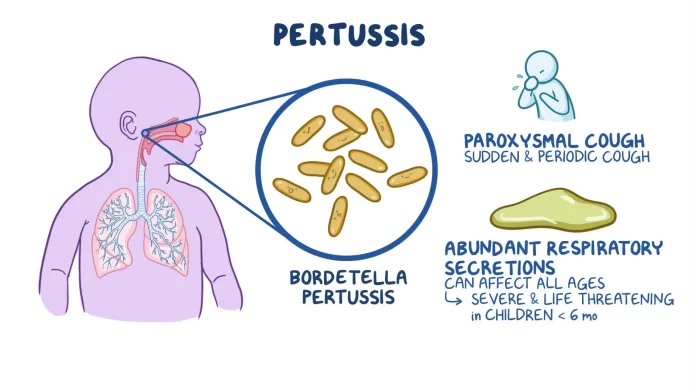Pertussis, also known as whooping cough, is a highly contagious respiratory disease caused by the bacterium Bordetella pertussis. It is characterized by severe coughing fits that can last for weeks or even months. The disease can be particularly dangerous for infants and young children.
Symptoms of Pertussis
Pertussis symptoms typically develop in stages:
- Catarrhal Stage (1-2 weeks):
- Mild cough
- Runny nose
- Sneezing
- Low-grade fever
- General malaise
- Paroxysmal Stage (1-6 weeks, up to 10 weeks):
- Severe coughing fits (paroxysms)
- Whooping sound when inhaling after a coughing fit (not always present)
- Vomiting after coughing
- Exhaustion after coughing fits
- Cyanosis (bluish skin) due to lack of oxygen during coughing fits
- Convalescent Stage (weeks to months):
- Gradual recovery
- Coughing lessens but may recur with respiratory infections
Causes
Pertussis is caused by the bacterium Bordetella pertussis. It spreads through respiratory droplets when an infected person coughs or sneezes. The bacterium attaches to the cilia of the respiratory epithelial cells, releasing toxins that damage the cilia and cause inflammation of the respiratory tract.
Treatment of Pertussis
- Antibiotics:
- Erythromycin, clarithromycin, or azithromycin are commonly prescribed.
- Antibiotics are most effective when given during the early catarrhal stage.
- They can help reduce the severity and duration of symptoms and prevent spread to others.
- Supportive Care:
- Hospitalization may be necessary for severe cases, especially in infants.
- Oxygen therapy for those with breathing difficulties.
- Intravenous fluids to prevent dehydration due to vomiting.
- Close monitoring to manage complications such as pneumonia or seizures.
Prevention
- Vaccination:
- The primary method of preventing pertussis is through vaccination.
- The DTaP vaccine (diphtheria, tetanus, and acellular pertussis) is given to infants and children.
- The Tdap booster vaccine is recommended for adolescents and adults, particularly for pregnant women and those in close contact with infants.
- Hygiene Practices:
- Frequent hand washing.
- Covering mouth and nose when coughing or sneezing.
- Avoiding close contact with infected individuals.
- Prophylactic Antibiotics:
- Given to close contacts of a person diagnosed with pertussis, especially in households with vulnerable individuals such as infants or pregnant women.
Conclusion
Pertussis remains a significant public health concern despite widespread vaccination efforts. Understanding the symptoms, causes, treatment options, and preventive measures is crucial for managing and controlling the spread of this contagious disease. Early diagnosis and prompt treatment can help reduce the severity of symptoms and prevent complications, particularly in high-risk populations.






























